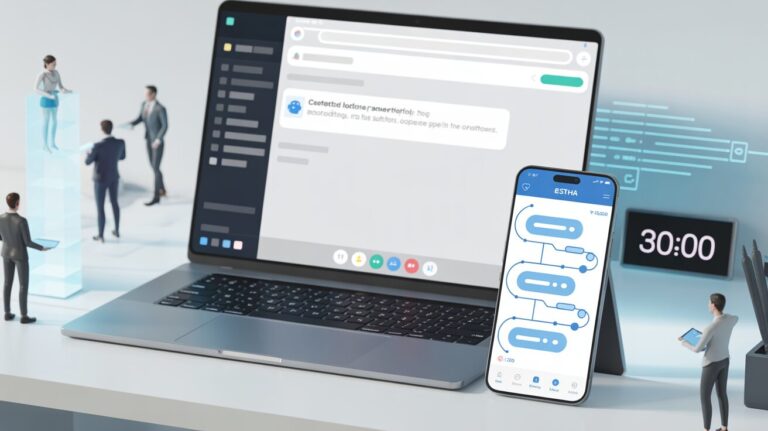Table Of Contents
- Introduction
- The Founder’s Background: No Technical Experience
- Identifying the Market Opportunity
- Choosing a No-Code AI Solution
- Building the MVP in Just Two Weeks
- Securing the First 10 Paying Customers
- Scaling Strategies That Worked
- The Path to $10K MRR
- Challenges and How They Were Overcome
- Key Lessons Learned
- Conclusion
In the world of startups and digital entrepreneurship, the journey from idea to profitable business is often portrayed as requiring extensive technical knowledge, coding skills, and significant investment. But what if that paradigm is shifting? What if building a successful AI-powered business is now possible for anyone with domain expertise, regardless of their technical background?
This case study tells the remarkable story of Sarah Chen, a marketing professional who transformed her industry expertise into a thriving AI business generating $10,000 in monthly recurring revenue (MRR) – without writing a single line of code. Using no-code AI platforms similar to Estha, Sarah went from initial concept to profitable business in under six months, proving that the democratization of AI is creating unprecedented opportunities for non-technical entrepreneurs.
We’ll dive deep into Sarah’s journey, exploring the specific steps she took, the challenges she faced, and the strategies that ultimately led to her success. Whether you’re a professional looking to monetize your expertise, a small business owner seeking to leverage AI, or an entrepreneur searching for your next opportunity, this case study provides a blueprint for building a successful AI business without technical limitations.
From Zero To $10K MRR
With No-Code AI
How a non-technical founder built a thriving AI business using no-code tools
The Founder
Sarah Chen, a marketing professional with zero technical background, identified a common pain point: marketers spending 40% of their time on repetitive content creation tasks.
The Solution
Using a no-code AI platform with a drag-drop-link interface, Sarah built “BrandVoice” — an AI content assistant that generates brand-consistent marketing content across channels.
The 6-Month Journey to $10K MRR
MVP in 14 Days
Built a working prototype in just two weeks without writing a single line of code
First 10 Customers
Secured initial customers through free pilots with a simple proposition: pay if it saves 5+ hours
Tiered Pricing
Increased average revenue from $99 to $295 per customer with strategic pricing tiers
Rapid Feature Expansion
Added new capabilities like product descriptions and blog outlines based on customer feedback
Enterprise Solution
Crossed $10K MRR by developing a custom solution for an e-commerce client with 800+ SKUs
Key Success Factors
Domain Expertise > Technical Skills
Sarah’s marketing background was more valuable than coding knowledge in identifying real customer problems.
Start Narrow, Then Expand
Beginning with a focused solution (social media content) allowed for exceptional value before expanding features.
Charge From Day One
Monetization from the start validated the value proposition and provided resources for continued growth.
No Coding Required
Sarah built and scaled BrandVoice to $10K MRR without writing a single line of code, focusing instead on customer needs and business logic.
Time to MVP
14 Days
Customer Retention
92%
Time to $10K MRR
6 Months
Your Expertise + No-Code AI = Business Opportunity
Domain knowledge and industry expertise are now more valuable than technical skills in building successful AI businesses.
The Founder’s Background: No Technical Experience
Sarah Chen didn’t fit the stereotypical profile of a tech founder. With a background in digital marketing and five years of experience managing campaigns for e-commerce brands, she possessed valuable domain expertise but lacked the technical skills traditionally associated with building AI solutions.
“I always had ideas for tools that could solve problems I encountered daily in my marketing role,” Sarah explains, “but I assumed building them would require hiring developers or learning to code myself – both options seemed out of reach given my limited resources.”
Sarah’s career had given her insights into specific pain points experienced by marketing teams. She understood the challenges of creating consistent, on-brand content across multiple channels and the time constraints facing marketing departments. More importantly, she recognized that these problems were widespread enough to build a business around solving them.
What Sarah lacked in technical skills, she made up for in industry knowledge, customer empathy, and entrepreneurial drive. These qualities would prove more valuable than coding abilities in her journey to building a successful AI business.
Identifying the Market Opportunity
The genesis of Sarah’s business idea came from her own frustrations. As a marketing manager, she spent hours each week creating social media captions, email subject lines, and ad copy variations – tedious tasks that followed predictable patterns but consumed valuable creative energy.
“I noticed that about 40% of my time was spent on repetitive content creation tasks that followed our brand guidelines,” Sarah recalls. “I thought: what if I could build an AI assistant that understood our brand voice and could generate this content automatically?”
To validate her idea, Sarah conducted interviews with 25 marketing professionals in her network. The results confirmed her suspicions: 22 of them spent at least 15 hours weekly on similar repetitive content tasks, and all expressed interest in an AI solution tailored to their brand voice.
Further market research revealed that existing AI writing tools offered generic outputs that rarely matched specific brand voices without extensive editing. This gap represented a significant opportunity: a vertical AI solution specifically designed for brand-consistent content generation.
The Target Customer
Through her research, Sarah identified her ideal customer profile: marketing managers at direct-to-consumer brands with 10-50 employees. These companies were large enough to have substantial content needs but typically lacked specialized AI resources or large creative teams. They valued brand consistency but struggled to maintain it across growing channel requirements.
With a clear market opportunity and defined customer profile, Sarah was ready to build her solution – but the technical hurdles remained. This is where no-code AI platforms would prove transformative.
Choosing a No-Code AI Solution
Sarah’s breakthrough came when she discovered the emerging category of no-code AI platforms. These solutions promised to let non-technical users create custom AI applications without programming knowledge – exactly what she needed.
“I evaluated several platforms based on three key criteria,” Sarah explains. “First, how quickly could I build and iterate on my solution? Second, how closely could I customize the AI to understand specific brand voices? And third, how easily could I deploy it as a commercial product?”
After testing multiple options, Sarah selected a no-code AI platform with an intuitive drag-drop-link interface similar to Estha. The platform allowed her to create custom AI applications by connecting pre-built components rather than writing code.
Key features that influenced her decision included:
- The ability to train AI on brand-specific content examples
- A visual interface for creating application flows without coding
- Built-in deployment options, including embeddable widgets and APIs
- Subscription pricing that scaled with usage
“What impressed me most was how the platform handled the technical complexity behind the scenes,” Sarah notes. “I could focus on what I knew best – understanding the marketing use case and customer needs – while the platform managed the AI implementation.”
Building the MVP in Just Two Weeks
With her no-code platform selected, Sarah began building her Minimum Viable Product (MVP): an AI content assistant she named “BrandVoice.” The goal was to create a solution that could generate social media posts, email headlines, and product descriptions in a customer’s specific brand voice.
The Development Process
Sarah’s development process consisted of four key stages, all accomplished without writing code:
First, she created the data structure for her application. She defined content types (social posts, email subjects, etc.), brand attributes (tone, style, taboo words), and output formats. Using the platform’s visual interface, she mapped these relationships in a way the AI could understand.
Second, she built the user interface using drag-and-drop components. She created input forms where users could upload brand guidelines, example content, and specify what they needed to generate. The interface was simple but effective, focusing on essential functionality.
Third, she configured the AI engine using the platform’s training tools. This involved uploading examples of branded content and creating “rules” that helped the AI understand different brand voices. Sarah spent most of her time here, as this was crucial to delivering value.
Finally, she set up integration options so customers could access BrandVoice through a web application or embed it directly in their marketing tools.
“The entire process took 14 days from start to finish,” Sarah recalls. “I spent about 3-4 hours each day working on it, mainly focused on refining how the AI understood brand guidelines and produced appropriate content.”
What’s remarkable is that Sarah accomplished all this without technical assistance. The no-code platform handled the complex AI implementation, allowing her to focus on the business logic and user experience.
Securing the First 10 Paying Customers
With her MVP ready, Sarah faced the next challenge: convincing someone to pay for it. Her approach to finding early customers leveraged her existing professional network and focused on demonstrating immediate value.
Starting With Free Pilots
Sarah identified five marketing managers from her network who had expressed interest during her initial research. She offered them a two-week free pilot of BrandVoice with a simple proposition: if the tool saved at least 5 hours of work during the trial, they would become paying customers.
“I made onboarding incredibly hands-on,” Sarah explains. “I personally helped each pilot customer upload their brand guidelines and example content. Then I showed them how to use the system to generate the specific content types they needed most.”
This high-touch approach paid off. Four of the five pilot users reported saving 7-10 hours during the two-week trial, and three immediately converted to paying customers at $99/month.
Leveraging Success Stories
With three customers on board, Sarah documented their experiences as case studies, highlighting specific examples of content BrandVoice had generated and the time saved. She used these case studies in targeted outreach to similar companies.
“Having real examples from peers in their industry made a huge difference,” Sarah notes. “Potential customers could immediately see how BrandVoice would work for their specific needs.”
This approach helped Sarah secure seven more customers over the next month, bringing her total to 10 paying accounts and her first $1,000 in MRR – a significant milestone achieved just three months after her initial idea.
Scaling Strategies That Worked
With 10 customers and validated product-market fit, Sarah began implementing strategies to grow BrandVoice more systematically. Her approach combined product improvements, pricing optimization, and targeted marketing.
Expanding Product Capabilities
Customer feedback revealed opportunities to expand BrandVoice’s capabilities. Using her no-code platform, Sarah quickly added new features:
She expanded content types to include product descriptions, blog outlines, and customer service responses. Each addition opened up new use cases and departments within existing customer companies.
She implemented a “learning” feature that allowed the AI to improve based on user feedback, gradually enhancing accuracy for each customer’s brand voice. This was achieved by creating feedback loops within the no-code platform.
She built simple integrations with popular marketing tools, allowing BrandVoice to work within customers’ existing workflows. The no-code platform provided pre-built connectors that made these integrations possible without technical expertise.
Optimizing Pricing Structure
Sarah’s initial $99/month flat fee was quickly outgrown as she added features and supported larger customers. She implemented a tiered pricing structure:
- Starter ($149/month): For small teams with basic needs
- Professional ($349/month): For marketing departments with multiple users
- Enterprise ($749/month): For companies needing multiple brand voices and advanced features
This pricing strategy increased average revenue per customer from $99 to $278, instantly boosting MRR without requiring new customer acquisition.
Content Marketing and Community Building
Sarah leveraged her marketing background to implement effective growth strategies:
She created detailed content about AI for marketers, establishing herself as a thought leader at the intersection of AI and brand marketing. Articles like “5 Ways AI Can Maintain Brand Consistency” generated qualified leads.
She built a community of marketing professionals interested in AI, hosting monthly virtual meetups to discuss trends and share best practices. This community became a reliable source of referrals and new customers.
These scaling strategies helped Sarah grow from 10 to 35 paying customers within four months, bringing her MRR to approximately $9,730.
The Path to $10K MRR
Sarah’s journey from $1,000 to $10,000 in monthly recurring revenue took approximately six months and involved both expected growth and unexpected opportunities. The key milestones along this path demonstrate how no-code AI tools enabled rapid scaling.
Key Growth Metrics
Sarah tracked several metrics to understand her growth trajectory:
Customer acquisition grew from 3-4 new customers per month initially to 8-10 per month by month six. Word-of-mouth referrals accounted for approximately 40% of new business, with content marketing and direct outreach driving the remainder.
Customer retention reached 92% monthly, with most cancellations coming from the smallest tier of customers. Enterprise customers maintained 100% retention throughout the period.
Average revenue per customer increased from $99 initially to $295 by month six as customers upgraded to higher tiers and added additional features.
Breaking the $10K Threshold
The final push to $10,000 MRR came from an unexpected opportunity. One of Sarah’s enterprise customers, a direct-to-consumer beauty brand, requested a custom version of BrandVoice that could generate product descriptions at scale for their 800+ SKU catalog.
“They were launching on a new e-commerce platform and needed to rewrite all their product descriptions in a consistent voice,” Sarah explains. “Manually, this would have taken weeks and cost thousands in freelance writing.”
Using her no-code platform, Sarah customized BrandVoice to handle batch processing of product attributes into compelling descriptions. She created this custom solution in just three days and charged a $1,500 setup fee plus an increased monthly subscription of $999.
This single opportunity pushed Sarah over the $10K MRR milestone and opened a new market segment: e-commerce companies with large product catalogs needing AI-generated content at scale.
“What amazed me was how quickly I could adapt my solution to this new use case,” Sarah notes. “Without no-code tools, developing this custom functionality would have required hiring developers and weeks of work.”
Challenges and How They Were Overcome
Sarah’s journey wasn’t without obstacles. Several significant challenges tested her resolve and required creative solutions – all without technical expertise.
Challenge #1: AI Accuracy and Consistency
Early versions of BrandVoice sometimes produced content that didn’t perfectly match a brand’s voice, particularly for brands with complex guidelines or unique terminology.
Solution: Sarah improved the training process by creating a more structured approach to onboarding new brands. She developed a questionnaire that captured specific brand attributes and created a feedback mechanism that allowed the AI to learn from corrections. Using the no-code platform’s machine learning capabilities, she implemented a system that improved accuracy over time without requiring technical intervention.
Challenge #2: Scaling Customer Support
As customer numbers grew, Sarah found herself spending increasing amounts of time on support requests and onboarding new users.
Solution: Sarah used her own product to create an AI assistant that could handle common customer questions. Using the same no-code platform that powered BrandVoice, she built a customer support chatbot trained on her product documentation and common issues. This automated assistant handled approximately 70% of support inquiries, freeing Sarah to focus on growth activities.
Challenge #3: Competition from Larger Players
Six months into Sarah’s journey, several well-funded competitors entered the market with similar AI content solutions.
Solution: Rather than competing directly on features, Sarah doubled down on specialization. She focused BrandVoice specifically on direct-to-consumer brands in fashion, beauty, and lifestyle categories – industries she knew intimately from her background. This vertical focus allowed her to create AI models that outperformed general-purpose competitors in these specific niches, maintaining her competitive advantage despite limited resources.
“These challenges taught me that agility is my greatest advantage,” Sarah reflects. “Without being tied to complex codebases or technical debt, I could rapidly adapt my product to address problems and opportunities. The no-code approach gave me a flexibility that even well-funded competitors couldn’t match.”
Key Lessons Learned
Sarah’s journey from idea to $10K MRR offers valuable insights for anyone considering building an AI business without technical expertise. Here are the most important lessons she shared:
Domain Expertise Trumps Technical Skills
“My deep understanding of marketing challenges was far more valuable than coding skills would have been,” Sarah emphasizes. “I could immediately recognize which AI capabilities would solve real problems because I’d experienced those problems firsthand.”
This insight suggests that subject matter experts across various industries – healthcare professionals, educators, financial advisors, and others – are uniquely positioned to identify valuable AI applications in their domains.
Start Narrow, Then Expand
BrandVoice began with a highly focused use case: generating social media content in a specific brand voice. This narrow focus allowed Sarah to create exceptional value in one area before expanding to adjacent needs.
“I’ve seen too many founders try to build comprehensive AI solutions immediately,” Sarah notes. “By starting with one very specific problem, I could deliver extraordinary results that got customers excited.”
No-Code Platforms Enable Rapid Iteration
Perhaps the most critical lesson was how no-code platforms changed the innovation equation. Sarah typically implemented customer feedback and launched new features in days rather than weeks or months.
“The ability to modify my AI application without technical dependencies was transformative,” she explains. “When a customer suggested a new feature, I could often implement it the same week. This rapid iteration cycle created incredible loyalty and word-of-mouth growth.”
Monetization Should Come Early
Unlike many startups that focus on user growth before revenue, Sarah charged for BrandVoice from the beginning. This approach validated her value proposition and provided resources for continued development.
“Charging from day one forced me to create genuine value,” she says. “It also meant that every feature I added had a clear purpose: helping customers achieve results they were willing to pay for.”
Conclusion
Sarah Chen’s journey from marketing professional to successful AI entrepreneur exemplifies a profound shift in who can build and profit from artificial intelligence. Without writing a single line of code, she created a valuable AI solution that generates $10,000 in monthly recurring revenue and continues to grow.
The key enabler in this story was access to no-code AI development platforms that handled the technical complexity while allowing Sarah to focus on her domain expertise and customer needs. These platforms are democratizing AI development, making it accessible to professionals across all industries.
For professionals considering similar ventures, Sarah’s advice is straightforward: “Start with a problem you understand deeply, find a no-code platform that lets you build a solution quickly, and get it in front of paying customers as soon as possible. The feedback loop between customer needs and your ability to implement solutions is where the magic happens.”
As no-code AI platforms like Estha continue to evolve, we can expect more success stories like Sarah’s – entrepreneurs leveraging their domain expertise to create valuable AI solutions without technical limitations. The democratization of AI development isn’t just changing who can build these tools; it’s fundamentally expanding the types of problems AI can solve by bringing diverse expertise into the development process.
The journey from 0 to $10K MRR is just the beginning. With the barriers to AI development continuing to fall, the opportunities for non-technical founders to build significant, valuable businesses using artificial intelligence have never been greater.
Ready to Build Your Own AI Success Story?
Turn your expertise into a powerful AI application – no coding required. Create custom AI solutions in minutes with Estha’s intuitive drag-drop-link interface.



